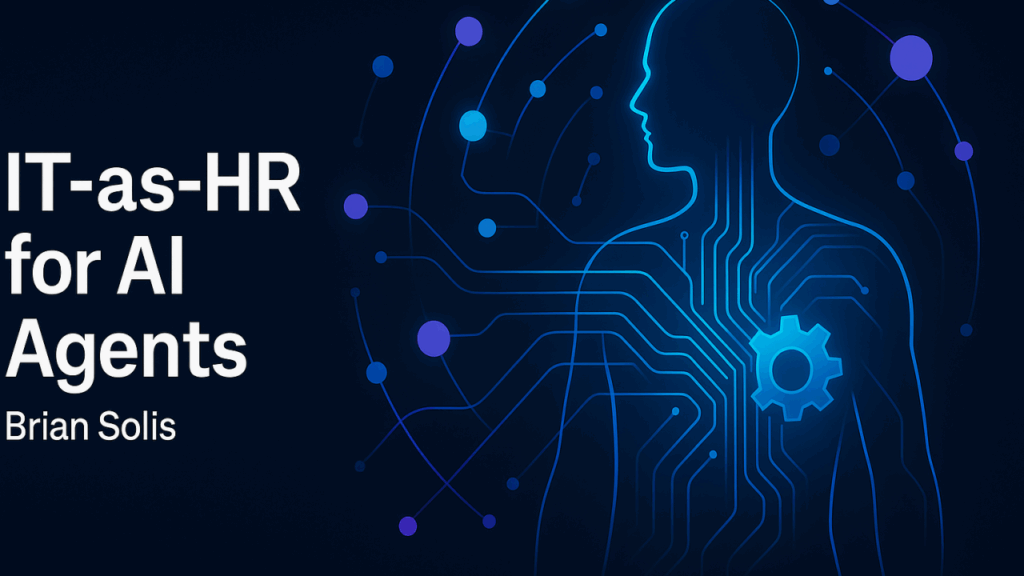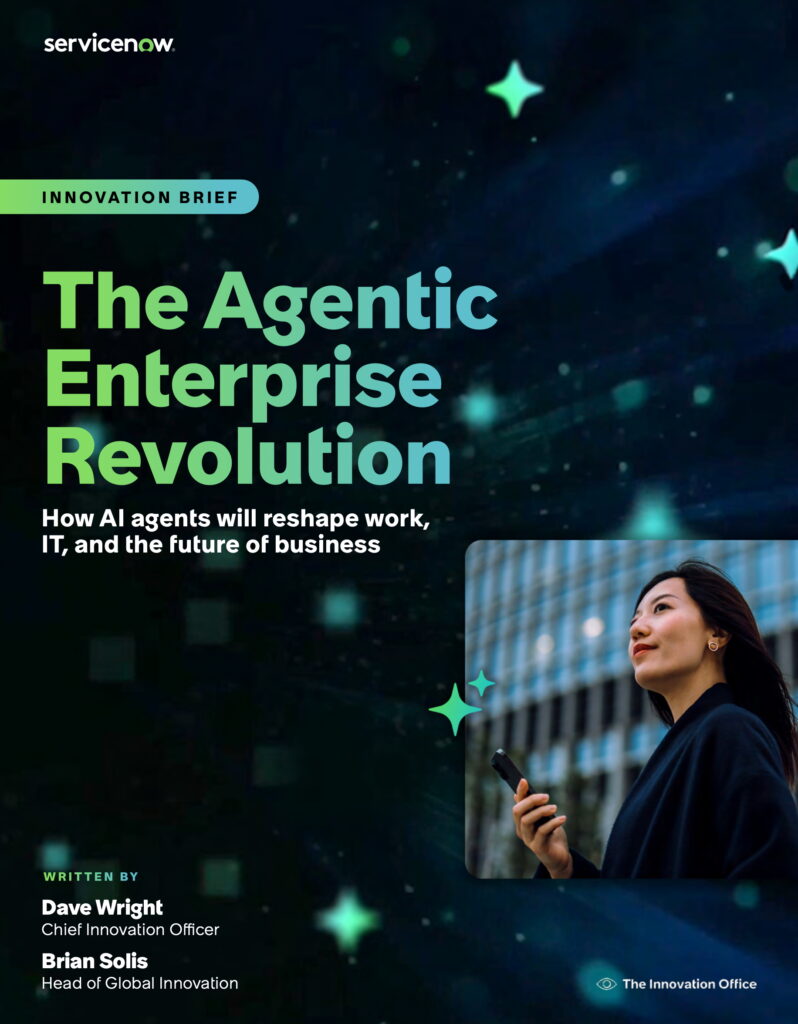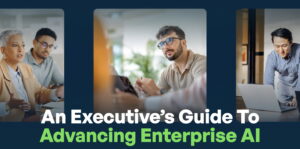
I’m so excited to share this with you…as part of the new “Innovation Office” we’re building at ServiceNow, we will produce original research and thought leadership to help our colleagues, customers, and partners (and you!) transcend macro and micro trends into opportunities for innovation and business transformation. Our first series of publications are branded “Innovation Briefs.” They are short-form hybrid reports that combine research, practitioner-based thought leadership, and futurism…all meant to be read and actionable by everyone.
In a lot of ways, the IT department of every company is going to be the HR department of AI agents in the future.” — Jensen Huang.
We’re standing at the edge of a structural shift in how work is designed and delivered. Agentic AI isn’t just another toolset; it’s a digital workforce that will learn, adapt, and increasingly act on business goals with minimal supervision. Gartner now lists “Agentic AI” as a top strategic trend and projects that by 2028, at least 15% of day-to-day work decisions will be made autonomously.

In one of our first Innovation Briefs, “The Agentic Enterprise Revolution,” Dave Wright and I explore how the first wave of AI agents could fragment across functions unless someone conducts the symphony. That “someone” is a new form of IT or someone willing to orchestrate agents working with IT and key business unites and functions. This new role is reimagined as the orchestrator of a hybrid workforce where human expertise and AI agents collaborate across systems of record and action. It’s a big, bold idea. But it’s also one that’s inevitable to thoughtfully consider and grasp.
Think lifecycle management for agents: recruiting, onboarding, training, performance management, reskilling, and yes…offboarding. You could also think of agents as assets or agents on an org or work chart.
One approach is that IT becomes the HR of AI agents, accountable for the value, safety, outcomes, and continuous improvement of this digital workforce. The measure here becomes more than just uptime and throughput, but deflection rates, time-to-resolution, exception containment, and value per run. But this is just one approach.
From agents of chaos to an orchestra
Without orchestration from beginning to day-to-day to end, agents will run as designed, until they need to be optimized or unwound. One agent’s mistake can cascade across workflows. Our Innovation Brief calls for an orchestration layer (and ultimately a universal agent protocol) so agents can recruit one another, coordinate across platforms, and learn from results in real time. By 2030, we foresee the shift from “click-and-forget automation” to self-improving systems where agents evaluate their own success and evolve the flow of work.
The question becomes where to start, who leads agents, and how agents are orchestrated. One idea we propose is an evolution of IT to fulfill Jensen Huang’s idea of becoming HR for AI agents. But this is uncharted territory. Other unexplored opportunities are on the table.
A live case study: Moderna merged HR and IT
Here’s a provocative counter-move to Jensen’s framing. Instead of IT becoming HR for AI agents, Moderna literally merged HR and IT under one leader and it’s not who you might expect. Chief People and Digital Technology Officer Tracey Franklin has been tasked with leading a new merged function to “better architect the flow of work.” The rationale: redesign roles, tasks, and employee experience end-to-end, with AI integrated at the center of how work happens.
Reporting by The Wall Street Journal adds useful context: the integration followed an aggressive build-out of custom GPTs across the company (from clinical ops to HR), a reconfiguration of roles, and a push to separate tasks suited for humans from those optimized for automation. In other words, Moderna fused people systems and digital systems to manage one operating model.
Two models, one destination
- IT-as-HR (orchestrator model): Keep org charts mostly intact, but task the CIO and IT with managing the lifecycle and performance of a growing agent workforce, rooted in governance, standards, cross-platform coordination, ROI, and safety (as defined by the CoE). This emphasizes interoperability (think universal agent protocol) across the enterprise stack.
- People+Digital (fusion model): Collapse HR and IT into a single “flow of work” organization. Make talent, culture, skills, and systems one portfolio with a single owner for job (re)design, agent deployment, and behavior change. Moderna’s move is an early, interesting, and maybe, minority, example.
Neither model is “right” for everyone; both attempt to solve the same puzzle: how to manage a blended workforce of humans and agents with clarity, accountability, and outcomes.
What leaders should do next
- Name the owner of orchestration. Whether it’s IT, a fused People+Digital office, or a cross-functional council, assign accountability for agent lifecycle, cross-platform standards, and performance management.
- Stand up an Agent Control Tower. Instrument the flows end-to-end. Track agent utilization, quality, exception rates, safety/compliance, deflection, and outcome metrics tied to business goals.
- Design jobs as human-agent systems. Break work into outcomes and constraints; allocate tasks to humans or agents accordingly. Build learning loops so every pass improves prompts, policies, and playbooks.
- Invest in interoperability. Push vendors (and internal teams) toward open, cross-platform agent handshakes. True platform companies will shine here. Begin piloting a “universal agent protocol” across a cross-functional workflow approach so agents can recruit and collaborate across HR, IT, finance, supply chain, and CX.
- Set expectations: hype vs. value. Even as momentum builds, many “agentic” projects will stall due to cost and unclear value. Avoid “agent-washing.” Start with narrow, high-signal use cases and scale what proves ROI.
Why this matters now
We’re moving from systems of record to systems of results. The organizations that treat agents like first-class teammates, i.e. recruited, trained, governed, measured, will compound learning and throughput. The ones that sprinkle agents without orchestration will drown in complexity.
Jensen’s quote wasn’t a provocation. If you think about it, like we did, it’s a roadmap with different, viable, ways forward. Whether you empower IT to manage a digital workforce or take Moderna’s bolder route to fuse People and Digital, your next advantage will come from how you design the relationship between human creativity and machine agency.
If this resonated, you’ll love the deeper framework, examples, and operating model we lay out in The Agentic Enterprise Revolution: How AI Agents Will Reshape Work, IT, and the Future of Business. Download the innovation brief and share it with your leadership team to jump-start the conversation.
Mindshift | Keynote Speaker | Newsletter | Homepage





Leave a Reply